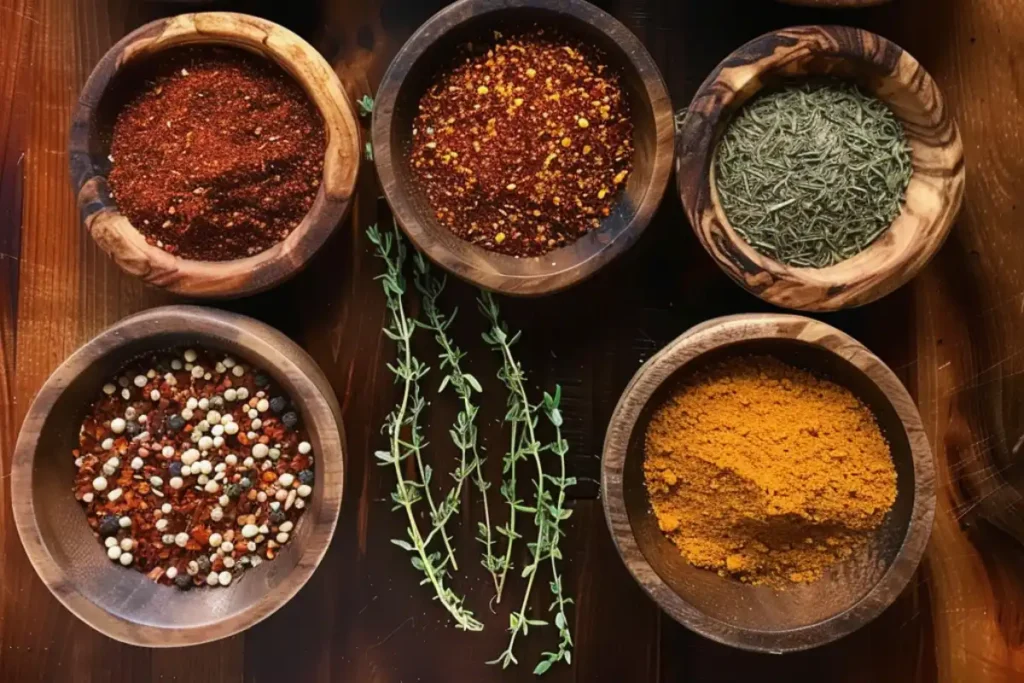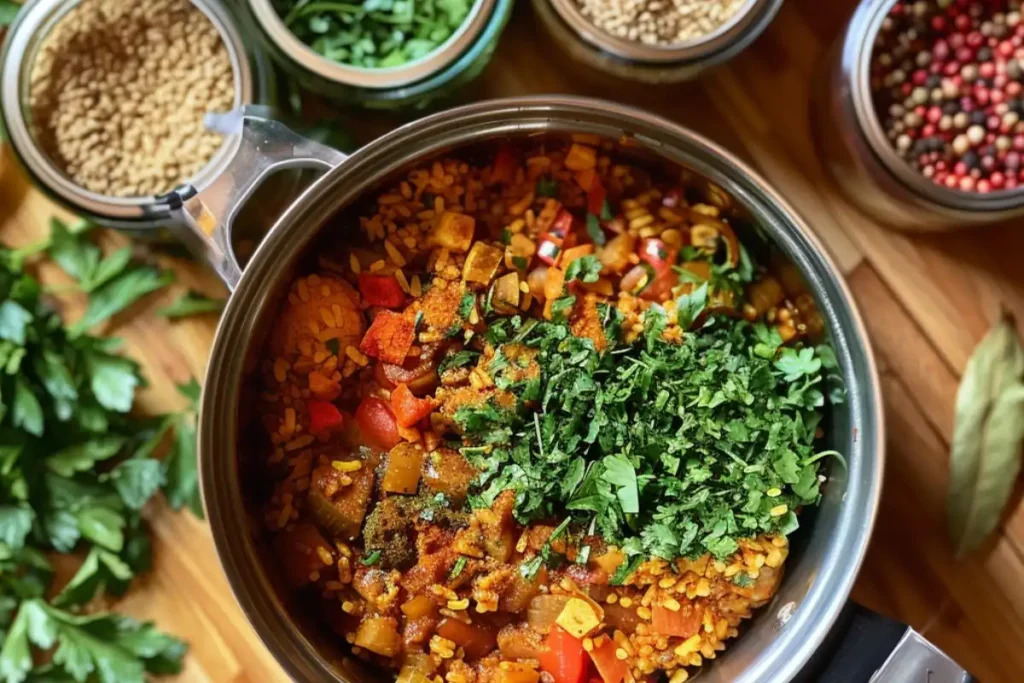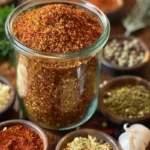Creole seasoning is an essential part of Louisiana cuisine, known for giving dishes like gumbo, jambalaya, and étouffée their rich, bold flavors. But what makes Creole seasoning so distinctive? Is it the fiery cayenne pepper, the fragrant thyme, or the subtle smokiness of paprika? This article takes an in-depth look into the key ingredients, origins, and various uses of this beloved spice blend.
Whether you want to understand how Creole seasoning has evolved, learn to make your own, or discover new ways to use it in your cooking, this comprehensive guide will provide all the information you need.
Table of Contents
The Origins of Creole Seasoning
Creole seasoning is an integral part of Creole cuisine, a rich cooking tradition that developed in Louisiana. With roots in French, Spanish, African, and Caribbean culinary traditions, This spice blend combines bold, flavorful spices that elevate the taste of dishes like gumbo, jambalaya, and étouffée.
Creole seasoning isn’t just a spice blend—it’s a reflection of the history and multicultural heritage of New Orleans. Its flavors reflect the complexity and vibrancy of the city’s melting pot of cultures. The blend’s versatility has also made it a go-to seasoning for Southern cooks looking to add depth and warmth to their meals.
Key Ingredients of Creole Seasoning

Primary Spices
The core ingredients in Creole seasoning are what give it its distinct flavor—bold, aromatic, and full of spice. While there are countless variations, most recipes share a few key components. Here’s a breakdown of the primary spices that define This spice blend:
- Paprika: This mild spice is the base of most Creole seasoning blends. Paprika brings a subtle sweetness to the mix, as well as a beautiful, deep red color that adds visual appeal to dishes. It’s a crucial ingredient in balancing the heat of the cayenne pepper.
- Cayenne Pepper: Known for its heat, cayenne pepper gives The Creole blend its signature kick. While not overwhelmingly spicy, cayenne adds just enough warmth to wake up the palate. It’s an essential component of Creole seasoning, especially for dishes that need a bold, spicy flavor.
- Thyme: One of the herbs that sets The Creole blend apart from other blends is thyme. This fragrant herb adds earthy, aromatic notes to the seasoning, rounding out the spice with a touch of herbal freshness.
- Garlic Powder: A staple in almost every Creole seasoning blend, garlic powder contributes to the savory backbone of the spice mix. It adds depth and umami, making the seasoning more robust and flavorful.
Additional Herbs and Seasonings
Beyond the core spices, This spice blend also contains a variety of herbs and other seasonings that contribute to its complexity. These include:
- Oregano: A Mediterranean herb, oregano is a common addition to Creole seasoning, adding a peppery, slightly bitter flavor that contrasts nicely with the sweetness of paprika.
- Onion Powder: Like garlic powder, onion powder provides another layer of savory depth to the seasoning. It enhances the overall flavor and adds a slight sweetness when cooked.
- Black and White Pepper: Both black and white pepper are frequently used in This spice blend. Black pepper provides a sharp, bold bite, while white pepper adds a more subtle, earthy heat.
Making Creole Seasoning at Home
Step-by-Step Recipe
Making your own Creole seasoning is a great way to ensure you have a fresh, flavorful blend that suits your taste preferences. By adjusting the heat, herbs, and salt levels, you can customize the seasoning to match your cooking style.
Here’s a simple, customizable recipe to make This spice blend at home:
Ingredients:
- 5 tablespoons paprika
- 3 tablespoons salt
- 2 tablespoons garlic powder
- 2 tablespoons onion powder
- 1 tablespoon black pepper
- 1 tablespoon white pepper
- 1 tablespoon cayenne pepper
- 2 tablespoons dried oregano
- 1 tablespoon dried thyme
Instructions:
- In a medium-sized mixing bowl, combine all the ingredients.
- Stir well to ensure that the spices are evenly distributed.
- Transfer the blend into an airtight container and store in a cool, dry place.
Customizations:
- Adjust the Heat: If you prefer a milder seasoning, reduce the amount of cayenne pepper or omit it entirely. If you like it spicier, feel free to add more.
- Lower the Salt: For a lower-sodium version, cut back on the salt or substitute with a salt alternative like Kosher salt or sea salt.
Storage and Shelf Life
To keep your homemade Spice mix fresh, store it in an airtight container. Keep it away from direct sunlight and heat. When stored properly, it can last up to six months. However, for the best flavor, try to use it within three months.
To maintain the freshness and potency of your seasoning, it's crucial to store spices correctly. Find out how to store spices properly
Uses of Creole Seasoning in Cooking

Classic Dishes
Creole seasoning is the secret behind the bold flavors of many classic Louisiana dishes. Here are some of the most popular recipes that rely on This spice blend to shine:
- Gumbo: This iconic Louisiana stew is typically made with a combination of seafood, chicken, and sausage. Creole seasoning is essential to building the complex flavors in the broth, especially when combined with the Holy Trinity of vegetables—onions, celery, and bell peppers.
- Jambalaya: A rice-based dish that’s as versatile as it is flavorful, jambalaya benefits from the bold, spicy kick of This spice blend. Whether you’re making Creole jambalaya (with tomatoes) or Cajun jambalaya (without tomatoes), the seasoning brings the dish to life.
- Etouffée: Another classic Louisiana dish, etouffée is typically made with crawfish or shrimp in a thick, flavorful sauce. This spice blend provides the perfect balance of spice and herbs to enhance the seafood’s natural flavors.
These traditional recipes wouldn’t be the same without the distinct flavor that spice mix provides. To learn more about enhancing these dishes with the right spices, explore this guide to Jambalaya seasoning.
Creative Uses
While Creole seasoning is most commonly associated with classic Southern dishes, it’s also a fantastic all-purpose seasoning that can be used in a variety of everyday meals. Here are some creative ways to incorporate spice mix into your cooking:
- Grilled Meats: Use spice mix as a dry rub for grilled chicken, steak, or pork. It adds a smoky, spicy flavor that pairs perfectly with the char of the grill.
- Roasted Vegetables: Sprinkle Creole seasoning over vegetables like potatoes, carrots, or zucchini before roasting for a flavorful, spiced twist.
- Soups and Stews: Add a teaspoon of this spice mix to soups and stews for an instant flavor boost. It works particularly well in heartier soups like bean or lentil stew.
Store-Bought Creole Seasoning vs. Homemade
When it comes to Creole seasoning, there’s often a debate between the convenience of store-bought blends and the quality of homemade versions. Here are the key differences:
- Flavor: While store-bought Creole seasoning is convenient, it often contains preservatives that can dull the flavors over time. Homemade seasoning, on the other hand, is fresh and customizable, offering a more vibrant taste.
- Cost: Although store-bought seasoning is readily available, making your own blend can save money in the long run—especially if you already have most of the spices on hand.
- Customizability: One of the biggest advantages of making your own Spice mix seasoning is the ability to adjust the ingredients to suit your preferences. You can control the heat, salt level, and herb combinations, tailoring the blend to fit your exact needs.
By making your own Creole seasoning, you ensure that every dish you cook is packed with the freshest, most flavorful ingredients possible.
For those who enjoy bold and flavorful dishes, this Creole Pasta recipe is a delicious way to explore the depth of Creole seasoning beyond traditional jambalaya.
Creole seasoning is more than just a spice blend. It reflects the rich, multicultural heritage of Louisiana cuisine. The bold combination of paprika, cayenne, garlic, and herbs gives depth and complexity to every dish. Whether you’re making traditional gumbo or seasoning vegetables, Creole seasoning brings vibrant flavors to your meals.
Making your own blend allows for customization. You can tailor the heat and herbs to your liking, ensuring each dish bursts with fresh flavors. So whether you’re cooking Southern classics or experimenting with new recipes, Creole seasoning is a must-have in your kitchen.
Frequently Asked Questions
What is Creole seasoning made of?
- typically consists of a blend of paprika, cayenne pepper, thyme, oregano, garlic powder, onion powder, and black pepper. Some variations may include additional herbs like bay leaf or parsley.
How is Creole seasoning different from Cajun seasoning?
- The key difference between Creole seasoning and Cajun is in their ingredients. Creole seasoning has more herbs like thyme and oregano. Cajun seasoning, on the other hand, focuses on heat with bold spices like cayenne and black pepper.
Can I substitute Cajun for Creole seasoning?
- Yes, you can substitute Cajun for Creole seasoning, but keep in mind that the dish will be spicier due to the higher concentration of cayenne and other hot spices in Cajun seasoning.
How long does homemade Creole seasoning last?
- When stored in an airtight container in a cool, dry place, homemade Spice mix can last for up to six months. However, for the best flavor, it’s recommended to use it within three months.
Creole Seasoning
This Creole Seasoning is a bold and flavorful blend of spices that brings authentic Louisiana-style taste to your dishes. Perfect for seasoning meats, seafood, rice, and classic Creole recipes like jambalaya and gumbo!
- Prep Time: 5 minutes
- Total Time: 5 minutes
- Category: Seasoning & Spices
- Method: No-Cook
Ingredients
For the Creole Seasoning:
- 2 tbsp paprika (smoked or sweet)
- 1 tbsp garlic powder
- 1 tbsp onion powder
- 1 tbsp dried oregano
- 1 tbsp dried thyme
- 1 tbsp salt
- 2 tsp black pepper
- 2 tsp cayenne pepper (adjust to taste)
- 1 tsp white pepper
- 1 tsp ground mustard
- 1 tsp dried basil
- ½ tsp ground cumin
Instructions
-
Mix the Seasoning:
- In a small bowl or spice jar, combine all spices.
- Stir or shake well until evenly mixed.
-
Use for Creole Dishes:
- Add 1 to 2 tsp per serving when seasoning meats, seafood, or rice dishes.
- Adjust according to taste and spice preference.
-
Store for Later:
- Transfer to an airtight container and store in a cool, dry place for up to 6 months.
Notes
- For a salt-free version, omit salt and add to taste when cooking.
- For extra heat, increase cayenne or add red pepper flakes.
- For more depth, use smoked paprika instead of sweet paprika.


